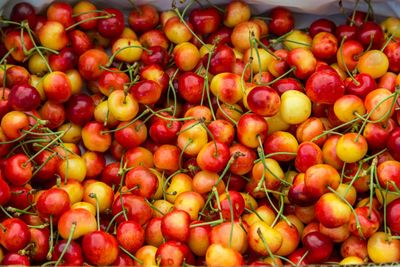About Rainier Cherry Trees
Rainier cherries resulted from a cross between the Bing and Van varieties. The trees are gorgeous in spring with showy pink-white blooms filling the garden with a lovely fragrance. This is followed by the next act: a large crop of outstanding cherries. For the grand finale in autumn, expect a fiery fall foliage display. The trees bear fruit early. Those with a Rainier in the backyard will be picking Rainier cherries in May or June, while other cherry trees are nowhere near ripe. Rainier sweet cherry fruit are yellow on the outside with a scarlet blush. The inner flesh is sweet and creamy white, giving it the nickname “white cherry.” Most gardeners agree that this is the best yellow cherry, and some insist that Rainier is the best cherry of any color. The large, yellow fruit is both bud hardy and crack resistant, giving it another edge over the competition. The cherries also tend to attract less birds than red cherries, probably due to the yellow coloring. The cherries store well too. They are wonderfully sweet right off the tree, but they also work well for baking, canning, and freezing.
How to Grow Rainier Cherries
If you are wondering how to grow Rainier cherries, the first step is to make sure that you live in an appropriate hardiness zone. Rainier cherry trees thrive in USDA plant hardiness zones 5 through 8. Plant the tree in loamy soil in a full sun location. Care of Rainier cherry trees is not harder than that of other cherry varieties, and includes irrigation, pest control, and occasional use of organic fertilizer. The trees grow to 35 feet (11 m.) tall, but can easily be kept smaller by pruning. This makes picking Rainier cherries easier and gives you the chance to remove dead and damaged wood. The tree is usually a heavy bearer, but it needs a pollinator. Black Tartarian, Sam, or Stella varieties work well and help keep those delicious cherries coming. Remember though, the tree takes some three to five years to fruit.
